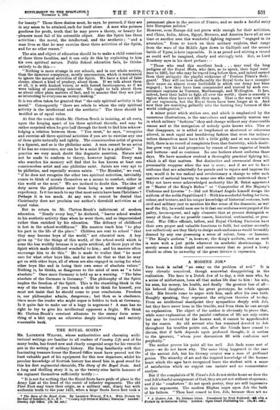THE ROYAL SCOTS.• Ma. LAURENCE WEAVER, whose authoritative and charming
archi- tectural writings are familiar to all readers of Country Life and of his many bookie has found new and clearly congenial scope for his versatile pen in the writing of military history. His long familiarity with that fascinating treasure-house the Record Office must have proved not the least valuable part of his equipment for this new departure, whilst his peculiar knowledge of Scottish history has stood him in good stead for this his first regimental chronicle, The Story of the Royal Scots. And a long and thrilling story it is, as the twenty-nine battle honours of the regiment themselves sufficiently testify :- " It is not for nothing that the Royal Scots have pride of place in the Army List at the heed of the roster of infantry regiments. The old First Foot may trace their origin, as a military unit, dimly but with authentic truth to the year 1421, when a large Scots force first took a
• The Story of the Royal Snobs. By Laurence Weaver, F.S.A. With Pram* by the Earl of Rosebery, E.G.. K.T. " C.Hodry Life Series of Military Ettaterlim" London : Country Life .tae. ad. net.1
permanent place in the service of Franco, and so made a fateful entry into European polities."
However, even Europe did not prove wide enough for their activities, and China, India, Africa, Egypt, Morocco, and America have all at one time or another seen this wonderful fighting regiment " engaged in its avocation." Even to touch on their military exploits, that range from the wars of the Middle Ages down to Gallipoli and the second battle of Ypres, is here impossible. It is as proud and stirring a record as could well bo imagined, clearly and stirringly told. But, as Lord Rosobery says in his short preface : — " Those who read this excellent book . . . may read the long pedigree of the Royal Shots, who date, so to speak, their legal exist- ence to 1662, but who may be traced long before then, and indeed earned from their antiquity the playful nickname of Pontius Pilate'a Body- guard.' They will see how ineffaceably the Royal Scott' have stamped their name on almost every battlefield in which our Army has boon engaged ; how they have been commanded and trusted by such con- summate captains as Turonno, Marlborough, and Wellington. It has, indeed,, been their habit to fight all over the world ; there is scarcely a region whore they have not left their mark. That is the way now with all our regiments, but the Royal Scots have been longer at it. And now they are marching gallantly into the burning fiery furnace of this world conflagration."
A minor point which strikes ono, and which is emphasized by the numerous illustrations, is the marvellous and apparently wanton way in which military "fashions" chop and ohango without any discoverable reason and at the instigation of nobody quite knows who. This or that disappears, or is added or lengthened or shortened or otherwise altered, in such rapid and bewildering fashion that oven the military tailors themselves must have felt a little giddy and at sea sometimes. Still, there is no record of complaints from that fraternity, which doubt- less grew very fat and prosperous by reason of them vagaries of braids and buttons—and so continue. No one bothers about uniforms them days. We have somehow evolved a thoroughly practical fighting kit, which is all that matters. But distinctive and ceremonial dross will presumably reappear when the war is over ; and if we are to have uniforms that are admittedly for parade and to rejoice and impress the eye, would it be too radical and revolutionary a change to refer such matters of sartorial bravery to some one who really understood them ? Why not have some acknowledged authority like M. Bakst appointee as " Master of the King's Robes " or " Comptroller of His Majesty's Uniforms and Liveries" ?—Did not Michael Angelo himself design the uniform of the noble Papal Guard ? —With his wonderful feeling fur form, colour, and texture, and his unique knowledge of historical costume, both civil and military (not to mention his fine sense of the dramatic, as web as of the fit), he would soon see to it that our uniforms wore purged of the paltry, inconsequent, and ugly elements that at prorent distinguish se many of them—for no possible reason, historical, sentimental, or prat:. tical. War Office officials, tailors, and Royal Clothing Factories hare their own proper and valuable functions to fulfil, but neither severally nor collectively are they likely to design such uniforms us would be readily donned by any one possessing a sense of colour, form --or humour. " The King's uniform " is, however, the King's uniform, and as such is worn with a just pride whatever its aesthetic shortcomings. It merely seems a little stupid and unnecessary that so proud a livery should so often be unworthy of the great Service it represents.














































 Previous page
Previous page